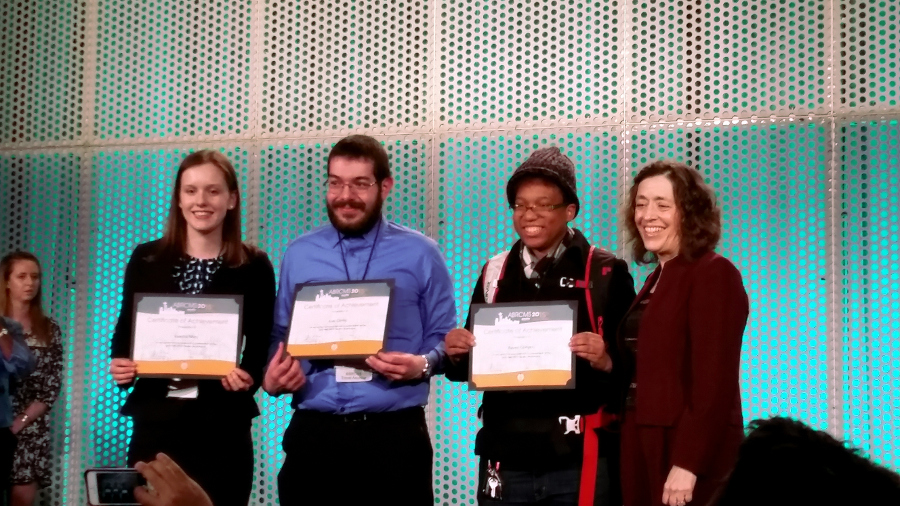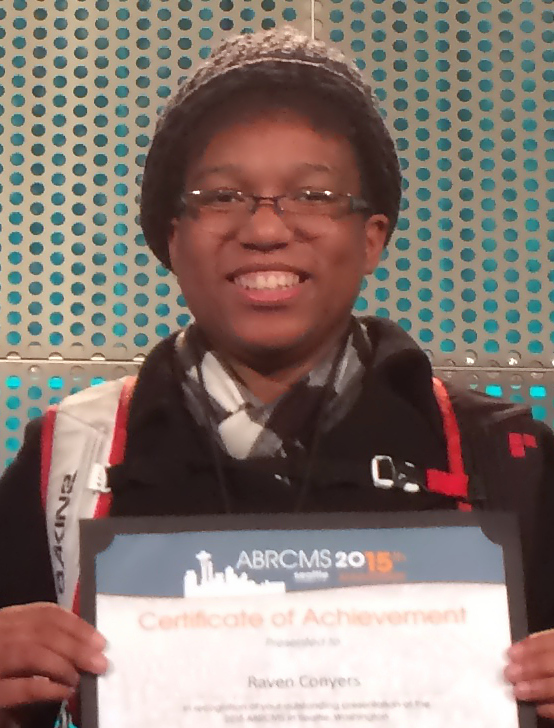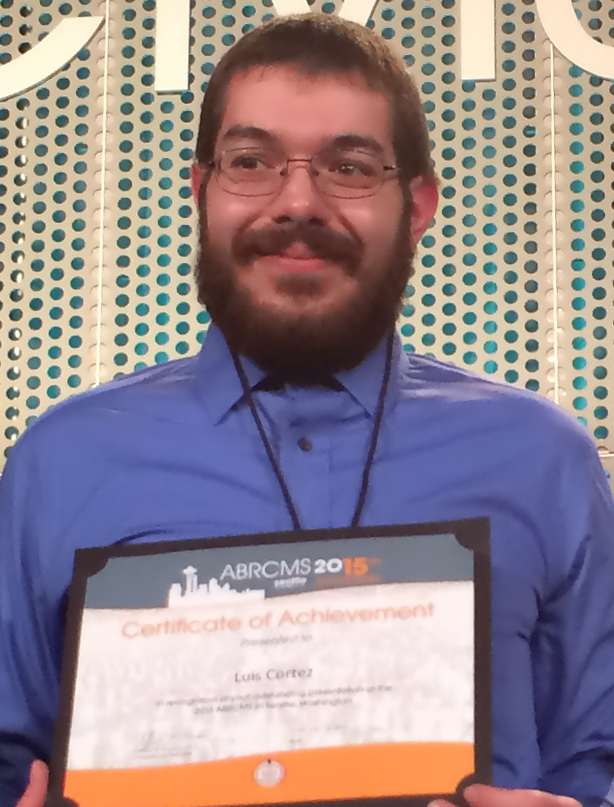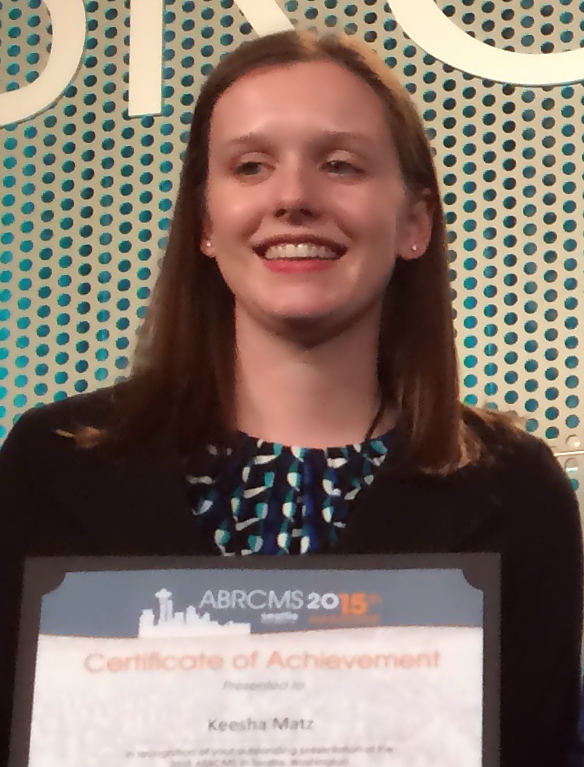Three WSU students land awards at national science research conference for minorities
MEDIA: Mary Sanchez Lanier, Assistant Vice Provost, WSU Undergraduate Education, 509-335-8239, sanchez@wsu.edu
PULLMAN, Wash.—Washington State University seniors Raven Conyers and Luis Cortez and sophomore Keesha Matz received awards for outstanding presentations at the recent Annual Biomedical Research Conference for Minority Students (ABRCMS) in Seattle.
ABRCMS is the largest professional conference for underrepresented minority students, military veterans, and persons with disabilities. It is supported by the National Institutes of Health’s National Institute of General Medical Sciences. Nearly 1,900 students were chosen to present research in 14 scientific disciplines, attend workshops, and meet representatives from universities and businesses.
Awardees’ research topics
 Conyers received a top prize in ABRCMS’ biochemistry category for her poster describing her research into “The Effect of FUdR on Fatty Acid Composition and Aging in Caenorhabditis elegans.” She is a 23-year old from Lynwood majoring in genetics and cell biology, and will attend the WSU College of Pharmacy next year. Her mentor is Jennifer Watts, associate professor in WSU’s School of Molecular Biosciences (SMB).
Conyers received a top prize in ABRCMS’ biochemistry category for her poster describing her research into “The Effect of FUdR on Fatty Acid Composition and Aging in Caenorhabditis elegans.” She is a 23-year old from Lynwood majoring in genetics and cell biology, and will attend the WSU College of Pharmacy next year. Her mentor is Jennifer Watts, associate professor in WSU’s School of Molecular Biosciences (SMB).
Cortez was a top awardee in the developmental biology and genetics category. His poster describes his investigation into “APOBEC Catalyzed Mutagenesis in DNA Replication Intermediates.” He is a 26-year-old from Othello double majoring in biochemistry plus genetics and cell biology. His mentor is Steven A. Roberts, assistant professor in SMB.
Matz was the best among the eight researchers specially chosen to make oral presentations in the microbiology category. Her topic is “Roles of Nipah Virus Attachment, Fusion, and Matrix Proteins on Viral Assembly and Budding.” She is a 19-year old from Chehalis majoring in microbiology and a member of the WSU Honors College. Her mentor is Hector Aguilar-Carreno, assistant professor in WSU’s Paul G. Allen School for Global Animal Health.
WSU well represented
From WSU, a total of six undergraduates, two graduate students, and one summer research participant delivered poster or oral presentations at ABRCMS. Only undergraduates are eligible for awards.
WSU Assistant Vice Provost Mary Sánchez Lanier teaches virology courses and serves frequently as an ABRCMS judge. “We had great students representing us at ABRCMS, and we applaud our award winners and every presenter from our university,” she said. “The caliber of work they are doing with their research faculty mentors gave WSU a real presence at this conference.”
Recognition and networking
The award winners said the benefits at ABRCMS went far beyond their cash awards and special acknowledgements at a closing dinner.
“Going to ABRCMS was the best experience of my life and it opened tons of doors to me,” said Conyers.
“The workshops and seminars were exceptional, as was meeting people,” Matz said. “ABRCMS gave me the confidence to apply for summer research experiences at other universities.”
“It was uplifting to me that people at ABRCMS were really interested in my work and my presentation, as much as I enjoyed presentations by other people,” said Cortez, who had presented his work at three professional meetings prior to ABRCMS.
Donor support from Scott and Linda Carson
Conyers, Cortez, and Matz were able to attend ABRCMS thanks to support from the Scott and Linda Carson Undergraduate Research Endowed Excellence Fund. This endowment was established in 2013 and is administered by the Office of Undergraduate Research, part of WSU Undergraduate Education. The Carsons are WSU alumni who have supported the university generously with their service and financial gifts for many years.
Conyers’ goal to help others heal
 Conyers aspires to be a nuclear pharmacist specializing in molecular pharmacology in a research setting. Inspired by a mentor who was by her side through a catastrophic illness as a teenager, she believes pharmacy will help her “use those skills to help others recover from illness.”
Conyers aspires to be a nuclear pharmacist specializing in molecular pharmacology in a research setting. Inspired by a mentor who was by her side through a catastrophic illness as a teenager, she believes pharmacy will help her “use those skills to help others recover from illness.”
She explained, “At 16, I was bed-bound in a hospital for weeks with Guillain-Barré Syndrome. The person who helped me most was the hospital pharmacist who visited me often and helped me understand the disease and medications.”
Guillain-Barré as “a rare disorder in which a person’s own immune system damages their nerve cells, causing muscle weakness and sometimes paralysis,” according to the website for the Centers for Disease Control and Prevention.
“I didn’t take much medicine at all because I didn’t want side effects. But it still bothered me there was really no medicine for the intense nerve pain. Then I had to re-learn how to walk and write. It took me more than two years to get back to being functional,” said Conyers. During that time, her family moved from Nevada to Washington; when she was able to return to high school, she caught up by taking chemistry, biology, and math courses at Everett Community College through Running Start.
She choose to continue her education at WSU in 2013 “because of all it stands for—a feeling of community, its school spirit, and opportunities for undergraduate research—one of my friends told me about that.”
At the close of her first year at WSU, she joined Watts’ lab. It explores mechanisms through which the physical properties and regulatory actions of specific lipids impact the cell biology and physiology of animals. Lab members use the nemotode model C. elegans and a combination of genetic, genomic, and biochemical approaches to understand the regulation, function, and biosynthesis of unsaturated fatty acids.
At ABRCMS, Conyers described her research efforts involving the nonparasitic worm, which is a popular model organism in labs because it is “easy to grow at room temperature, lives two-to-three weeks, and has similar genes to humans.” Since many labs use the cancer drug FUdR on the worms to inhibit reproduction, Conyers sought to find whether the drug alters the metabolism of C. elegans and whether this powerful drug should be used in aging experiments. She found that FUdR alters the fatty acid composition in the worms, which may significantly affect the outcomes of aging studies.
When not in the lab or studying, Conyers plays video games (Borderlands is a favorite), hikes, and enjoys time with friends and co-workers. For the past 10 months, she has moonlighted (literally) by driving for the Pullman company College Cabs from 4 p.m. until 4 a.m. on weekends.
“It’s so different from my other activities but it’s fun and a great way to meet interesting people. Some of them think I’m pretty interesting, too.”
Cortez’s interest in medicine
 Research wasn’t on the radar when Cortez landed grants and a Future Cougars of Color scholarship to attend WSU, but it will be his life’s work when his plans materialize to become a physician with a Ph.D.
Research wasn’t on the radar when Cortez landed grants and a Future Cougars of Color scholarship to attend WSU, but it will be his life’s work when his plans materialize to become a physician with a Ph.D.
“I want to research human health issues and also transfer my lab discoveries into practice,” he said. “I could say I want to cure cancer, but I’ll be very satisfied if I can find ways to prevent DNA damage and increase human longevity a bit.”
Cortez is a first-generation college student. His parents emigrated to the U.S. from the Florencia municipality in the state of Zacatecas in central Mexico. His father, Manuel, arrived in the 1970s, and his mother, Maria, in the late 1980s. Manuel died when Luis was 10, and Maria raised him in Othello.
“I was interested in science ever since I was a child, and I took every science class available in high school—biology was very easy for me,” said Cortez. While in high school he became interested in computer programming and considered a career as a software engineer; at WSU he first thought he’d major in computer science, but after taking a biology class for non-majors his second semester, he felt unsure. He took time off from college following his freshman year to think about what he really wanted to do.
“When I returned to Pullman, I did well in a two-semester, introductory biology course, and then in biochemistry and organic chemistry courses, and I was hooked. I began to think about graduate school and becoming a scientist. And I started to look for a faculty mentor to do research with.
“My advisor mentioned a new professor—Steve Roberts—and I asked if I could do volunteer work for him. I was the first undergraduate in his lab, and did basic experiments for nine hours a week. As I gained experience, he helped me become more independent. He’d give me a basic overview of a project, then I had to figure out the steps. Now in my second year in the lab, I’m paid to work on a line of research that I can feel personally responsible for while still working as part of a team of scientists.”
Cortez investigates a family of enzymes (APOBEC) which exist in mammalian cells and damage viruses that have invaded the cell as part of an innate immune response—they have been found to work against HIV. But the enzymes can latch onto any DNA, including the cell’s own DNA and cause mutations that can damage DNA as it’s replicating and potentially lead to cancer; furthermore, as cancer cells replicate at an elevated rate, the enzymes have an opportunity to exacerbate the mutagenesis in cancers. Based on the findings that Cortez presented at ABRCMS, the lab expanded its investigation into the whole genome. Cortez recently published a paper on his work titled, “APOBEC3A and APOBEC3B Preferentially Deaminate the Lagging Strand Template during DNA Replication” in Cell Reports; read it online at www.cell.com.
Cortez’s ABRCMS presentation was not his first. He shared his research at a 2014 LSAMP conference (Louis Stokes Alliances for Minority Participation program, a National Science Foundation-sponsored program for students in science, technology, engineering, and mathematics (STEM) programs with plans to earn doctoral degrees). He also presented at the SMB Conference with graduate student James Hoopes, and attended the LSAMP national conference in fall 2015, to which he received travel award to attend. In addition to the Carson scholarship, Cortez also received an ABRCMS award to help with travel expenses to the conference.
Matz’s path to science research, and the Nipah virus
 Having loved math and science since childhood, Matz decided in high school that she would aim for a career as a virology researcher at a government institution, such as the National Institutes of Health, or a biotechnology company.
Having loved math and science since childhood, Matz decided in high school that she would aim for a career as a virology researcher at a government institution, such as the National Institutes of Health, or a biotechnology company.
“I’ve always asked questions and worked toward answers, so figuring out my passion early has been very helpful,” she said. “I look forward to learning more about nature and discovering what no one else knows about.”
At W.F. West High School, she studied molecular genetics and DNA methylation patterns with award-winning teacher and WSU alumnus Henri Weeks. When it was time for college, she was determined to come to WSU.
“I preferred WSU because of its research reputation and also because of its STARS program, so I was very happy to get into both,” Matz said. The Students Targeted towards Advanced Research Studies (STARS) program in the School of Molecular Biology in the College of Veterinary Medicine provides a fast-track from undergraduate to graduate studies for selected students. Participants can earn a Ph.D. in seven years including B.S. and Ph.D. training and get involved in research laboratories starting in their baccalaureate program.
Her first research experience at WSU has been in Aguilar-Carreno’s lab in the Allen School. The lab studies entry mechanisms of highly pathogenic zoonotic viruses into mammalian cells. Aguilar-Carreno believes that a combination of multidisciplinary approaches will lead to anti-viral and vaccine strategies that target the zoonotic viruses he studies, and that have profound effects on global human and animal health.
Matz has worked on two projects in the lab, looking at the interactions of three proteins that affect how a virus—in this case, the notorious Nipah virus—replicates and exits a host cell, spreading infection.
Nipah virus was first identified in 1999 when 40 percent of 257 persons in Malaysia infected by it died. It was the model for the killer virus in the 2011 blockbuster film, “Contagion,” starring Gwyneth Paltrow. In the movie the virus that attacked and killed the star jumped to humans from pigs that had eaten food contaminated by guano from host-agent fruit bats. This is very close to what happens in real life. The lethal and little-known virus has no vaccine or cure, and targets the respiratory and nervous systems, especially the brain.
In Aguilar-Carreno’s biosafety level 2 laboratory (BSL-2) on the Pullman campus, Matz studies the virus using noninfectious viral-like particles that are incomplete Nipah microbes. Results from her and teammates’ work in the Aguilar-Carreno lab could lead to treatments for the Nipah virus, perhaps in the form of a vaccine or novel drug.
BSL-2 laboratories are equipped to work with moderate potential hazards such as the viral-like particles. The live Nipah virus is classified in the same category as Ebola virus—BSL-4 agents—capable of causing highly dangerous diseases that have no therapeutic treatments. The Centers for Disease Control and Prevention set four biosafety levels, with BSL-1 having the lowest degree of biocontainment precautions and BSL-4 having the highest.
Research is fun for Matz, who also participates in the molecular biosciences club and the WSU Honors College. In her free time she enjoys spending time outside bicycling touring, kayaking, hiking, and mountain climbing.
She is the daughter of Dale and Anne Matz.